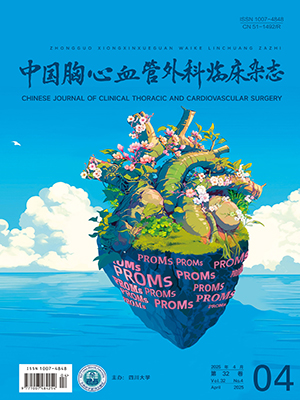| 1. |
Baumgartner H, Falk V, Bax JJ, et al. 2017 ESC/EACTS Guidelines for the management of valvular heart disease. Eur Heart J, 2017, 38(36): 2739-2791.
|
| 2. |
Leon MB, Smith CR, Mack M, et al. Transcatheter aortic-valve implantation for aortic stenosis in patients who cannot undergo surgery. N Engl J Med, 2010, 363(17): 1597-1607.
|
| 3. |
Leon MB, Smith CR, Mack MJ, et al. Transcatheter or surgical aortic-valve replacement in intermediate-risk patients. N Engl J Med, 2016, 374(17): 1609-1620.
|
| 4. |
Reardon MJ, Van Mieghem NM, Popma JJ, et al. Surgical or transcatheter aortic-valve replacement in intermediate-risk patients. N Engl J Med, 2017, 376(14): 1321-1331.
|
| 5. |
Thourani VH, Kodali S, Makkar RR, et al. Transcatheter aortic valve replacement versus surgical valve replacement in intermediate-risk patients: a propensity score analysis. Lancet, 2016, 387(10034): 2218-2225.
|
| 6. |
Siontis GC, Praz F, Pilgrim T, et al. Transcatheter aortic valve implantation vs. surgical aortic valve replacement for treatment of severe aortic stenosis: a meta-analysis of randomized trials. Eur Heart J, 2016, 37(47): 3503-3512.
|
| 7. |
Nishimura RA, Otto CM, Bonow RO, et al. 2017 AHA/ACC focused update of the 2014 AHA/ACC guideline for the management of patients with valvular heart disease: A report of the American College of Cardiology/American Heart Association Task Force on clinical practice guidelines. Circulation, 2017, 135(25): e1159-e1195.
|
| 8. |
Siemieniuk RA, Agoritsas T, Manja V, et al. Transcatheter versus surgical aortic valve replacement in patients with severe aortic stenosis at low and intermediate risk: systematic review and meta-analysis. Br Med J, 2016, 354: i5130.
|
| 9. |
Thyregod HG, Søndergaard L, Ihlemann N, et al. The Nordic aortic valve intervention(NOTION) trial comparing transcatheter versus surgical valve implantation: study protocol for a randomized controlled trial. Trials, 2013, 14: 1-11.
|
| 10. |
Mitrosz M, Kazimierczyk R, Sobkowicz BA, et al. The causes of thrombocytopenia after transcatheter aortic valve implantation. Thromb Res, 2017, 156: 39-44.
|
| 11. |
Lareyre F, Raffort J, Dommerc C, et al. Surgical management of percutaneous transfemoral access to minimize vascular complications related to transcatheter aortic valve' implantation. Angiology, 2018, 69(2): 143-150.
|
| 12. |
Urena M, Hayek S, Cheema AN, et al. Arrhythmia burden in elderly patients with severe aortic stenosis as determined by continuous electrocardiographic recording: toward a better understanding of arrhythmic events after transcatheter aortic valve replacement. Circulation, 2015, 131(5): 469-477.
|
| 13. |
Tchetche D, Farah B, Misuraca L, et al. Cerebrovascular events post-transcatheter aortic valve replacement in a large cohort of patients: a FRANCE-2 registry substudy. JACC Cardiovasc Interv, 2014, 7(10): 1138-1145.
|
| 14. |
Auffret V, Regueiro A, Del Trigo M, et al. Predictors of early cerebrovascular events in patients with aortic stenosis undergoing transcatheter aortic valve replacement. J Am Coll Cardiol, 2016, 68(7): 673-684.
|
| 15. |
Doerner J, Kupczyk PA, Wilsing M, et al. Cerebral white matter lesion burden is associated with the degree of aortic valve calcification and predicts peri-procedural cerebrovascular events in patients undergoing transcatheter aortic valve implantation (TAVI). Catheter Cardiovasc Interv, 2018, 91(4): 774-782.
|
| 16. |
Lansky AJ, Schofer J, Tchetche D, et al. A prospective randomized evaluation of the TriGuardTM HDH embolic DEFLECTion device during transcatheter aortic valve implantation: results from the DEFLECT Ⅲ trial. Eur Heart J, 2015, 36(31): 2070-2078.
|
| 17. |
Kapadia SR, Kodali S, Makkar R, et al. Protection against cerebral embolism during transcatheter aortic valve replacement. J Am Coll Cardiol, 2017, 69(4): 367-377.
|
| 18. |
Schmidt T, Leon MB, Mehran R, et al. Debris heterogeneity across different valve types captured by a cerebral protection system during transcatheter aortic valve replacement. JACC Cardiovasc Interv, 2018, 11(13): 1262-1273.
|
| 19. |
Nombela-Franco L, Webb JG, de Jaegere PP, et al. Timing, predictive factors, and prognostic value of cerebrovascular events in a large cohort of patients undergoing transcatheter aortic valve implantation. Circulation, 2012, 126(25): 3041-3053.
|
| 20. |
Tay EL, Gurvitch R, Wijesinghe N, et al. A high-risk period for cerebrovascular events exists after transcatheter aortic valve implantation. JACC Cardiovasc Interv, 2011, 4(12): 1290-1297.
|
| 21. |
Fuchs A, De Backer O, Brooks M, et al. Subclinical leaflet thickening and stent frame geometry in self-expanding transcatheter heart valves. EuroIntervention, 2017, 13(9): e1067-e1075.
|
| 22. |
Chakravarty T, Søndergaard L, Friedman J, et al. Subclinical leaflet thrombosis in surgical and transcatheter bioprosthetic aortic valves: an observational study. Lancet, 2017, 389(10087): 2383-2392.
|
| 23. |
Sondergaard L, De Backer O, Kofoed KF, et al. Natural history of subclinical leaflet thrombosis affecting motion in bioprosthetic aortic valves. Eur Heart J, 2017, 38(28): 2201-2207.
|
| 24. |
Amat-Santos IJ, Rodés-Cabau J, Urena M, et al. Incidence, predictive factors, and prognostic value of new-onset atrial fibrillation following transcatheter aortic valve implantation. J Am Coll Cardiol, 2012, 59(2): 178-188.
|
| 25. |
Tanawuttiwat T, O'Neill BP, Cohen MG, et al. New-onset atrial fibrillation after aortic valve replacement: comparison of transfemoral, transapical, transaortic, and surgical approaches. J Am Coll Cardiol, 2014, 63(15): 1510-1519.
|
| 26. |
Mérie C, Kober L, Skov Olsen P, et al. Association of warfarin therapy duration after bioprosthetic aortic valve replacement with risk of mortality, thromboembolic complications, and bleeding. JAMA, 2012, 308(20): 2118-2125.
|
| 27. |
Arai T, Romano M, Lefèvre T, et al. Direct comparison of feasibility and safety of transfemoral versus transaortic versus transapical transcatheter aortic valve replacement. JACC Cardiovasc Interv, 2016, 9(22): 2320-2325.
|
| 28. |
Sun Y, Liu X, Chen Z, et al. Meta-analysis of predictors of early severe bleeding in patients who underwent transcatheter aortic valve implantation. Am J Cardiol, 2017, 120(4): 655-661.
|
| 29. |
Stortecky S, Stefanini GG, Pilgrim T, et al. Validation of the valve academic research consortium bleeding definition in patients with severe aortic stenosis undergoing transcatheter aortic valve implantation. J Am Heart Assoc, 2015, 4(10): e002135.
|
| 30. |
Généreux P, Cohen DJ, Williams MR, et al. Bleeding complications after surgical aortic valve replacement compared with transcatheter aortic valve replacement: insights from the PARTNER I Trial (Placement of Aortic Transcatheter Valve). J Am Coll Cardiol, 2014, 63(11): 1100-1109.
|
| 31. |
Piccolo R, Pilgrim T, Franzone A, et al. Frequency, timing, and impact of access-site and non-access-site bleeding on mortality among patients undergoing transcatheter aortic valve replacement. JACC Cardiovasc Interv, 2017, 10(14): 1436-1446.
|
| 32. |
Hansson NC, Grove EL, Andersen HR, et al. Transcatheter aortic valve thrombosis: incidence, predisposing factors, and clinical implications. J Am Coll Cardiol, 2016, 68(19): 2059-2069.
|
| 33. |
Makkar RR, Fontana G, Jilaihawi H, et al. Possible subclinical leaflet thrombosis in bioprosthetic aortic valves. N Engl J Med, 2015, 373(21): 2015-2024.
|
| 34. |
Pache G, Schoechlin S, Blanke P, et al. Early hypo-attenuated leaflet thickening in balloon-expandable transcatheter aortic heart valves. Eur Heart J, 2016, 37(28): 2263-2271.
|
| 35. |
Cerrato E, Nombela-Franco L, Nazif TM, et al. Evaluation of current practices in transcatheter aortic valve implantation: The WRITTEN (WoRldwIde TAVI ExperieNce) survey. Int J Cardiol, 2017, 228: 640-647.
|
| 36. |
Abdul-Jawad Altisent O, Durand E, Muñoz-García AJ, et al. Warfarin and antiplatelet therapy versus warfarin alone for treating patients with atrial fibrillation undergoing transcatheter aortic valve replacement. JACC Cardiovasc Interv, 2016, 9(16): 1706-1717.
|
| 37. |
Noble S, Asgar A, Cartier R, et al. Anatomo-pathological analysis after CoreValve Revalving system implantation. EuroIntervention, 2009, 5(1): 78-85.
|
| 38. |
Ussia GP, Scarabelli M, Mule M, et al. Dual antiplatelet therapy versus aspirin alone in patients undergoing transcatheter aortic valve implantation. Am J Cardiol, 2011, 108(12): 1772-1776.
|
| 39. |
Stabile E, Pucciarelli A, Cota L, et al. SAT-TAVI (single antiplatelet therapy for TAVI) study: a pilot randomized study comparing double to single antiplatelet therapy for transcatheter aortic valve implantation. Int J Cardiol, 2014, 174(3): 624-627.
|
| 40. |
Rodés-Cabau J, Masson JB, Welsh RC, et al. Aspirin versus aspirin plus clopidogrel as antithrombotic treatment following transcatheter aortic valve replacement with a balloon-expandable valve: The ARTE (Aspirin Versus Aspirin+Clopidogrel Following Transcatheter Aortic Valve Implantation) randomized clinical trial. JACC Cardiovasc Interv, 2017, 10(13): 1357-1365.
|
| 41. |
Maes F, Stabile E, Ussia GP, et al. Meta-analysis comparing single versus dual antiplatelet therapy following transcatheter aortic valve implantation. Am J Cardiol, 2018, 122(2): 310-315.
|
| 42. |
Overtchouk P, Guedeney P, Rouanet S, et al. Long-term mortality and early valve dysfunction according to anticoagulation use: The FRANCE-TAVI registry. J Am Coll Cardiol, 2018, 73(1): 13-21.
|
| 43. |
Dentali F, Riva N, Crowther M, et al. Efficacy and safety of the novel oral anticoagulants in atrial fibrillation: a systematic review and meta-analysis of the literature. Circulation, 2012, 126(20): 2381-2391.
|
| 44. |
Seeger J, Gonska B, Rodewald C, et al. Apixaban in patients with atrial fibrillation after transfemoral aortic valve replacement. JACC Cardiovasc Interv, 2017, 10(1): 66-74.
|




